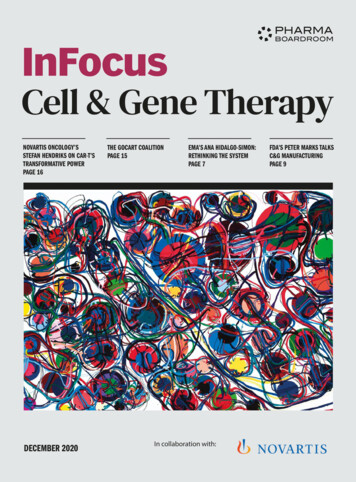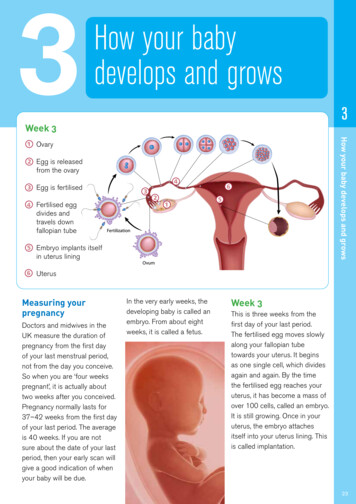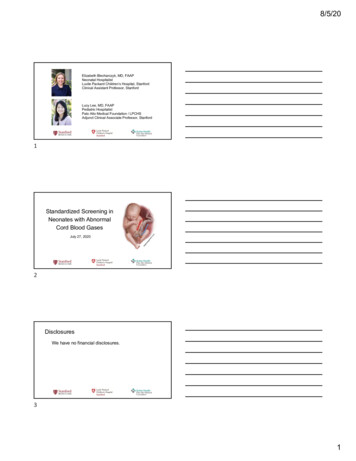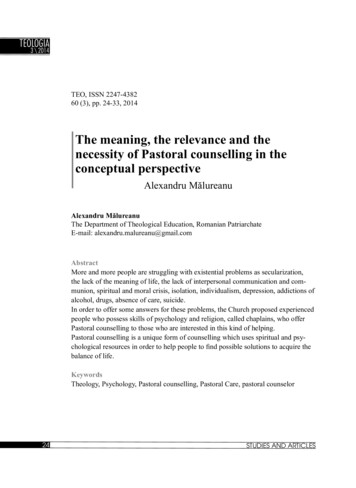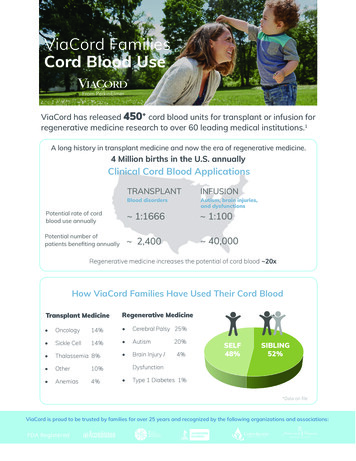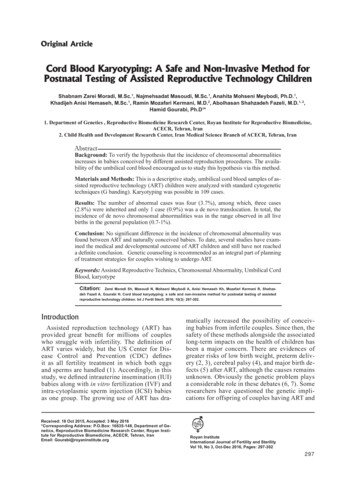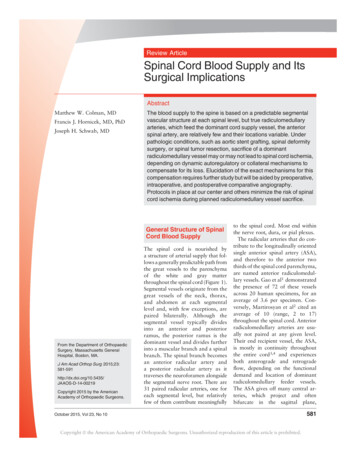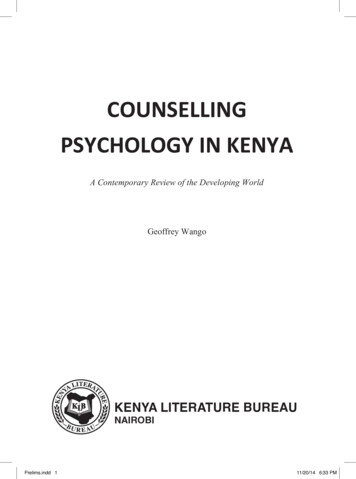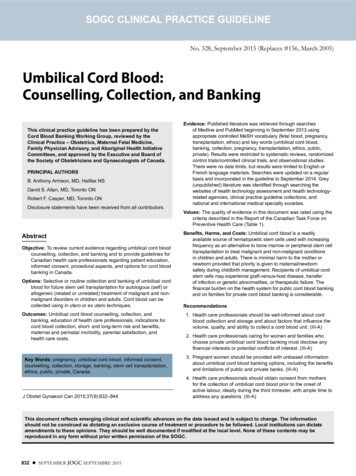
Transcription
SOGC CLINICAL PRACTICE GUIDELINENo. 328, September 2015 (Replaces #156, March 2005)Umbilical Cord Blood:Counselling, Collection, and BankingThis clinical practice guideline has been prepared by theCord Blood Banking Working Group, reviewed by theClinical Practice – Obstetrics, Maternal Fetal Medicine,Family Physician Advisory, and Aboriginal Health InitiativeCommittees, and approved by the Executive and Board ofthe Society of Obstetricians and Gynaecologists of Canada.PRINCIPAL AUTHORSB. Anthony Armson, MD, Halifax NSDavid S. Allan, MD, Toronto ONRobert F. Casper, MD, Toronto ONDisclosure statements have been received from all contributors.AbstractObjective: To review current evidence regarding umbilical cord bloodcounselling, collection, and banking and to provide guidelines forCanadian health care professionals regarding patient education,informed consent, procedural aspects, and options for cord bloodbanking in Canada.Options: Selective or routine collection and banking of umbilical cordblood for future stem cell transplantation for autologous (self) orallogeneic (related or unrelated) treatment of malignant and nonmalignant disorders in children and adults. Cord blood can becollected using in utero or ex utero techniques.Outcomes: Umbilical cord blood counselling, collection, andbanking, education of health care professionals, indications forcord blood collection, short- and long-term risk and benefits,maternal and perinatal morbidity, parental satisfaction, andhealth care costs.Key Words: pregnancy, umbilical cord blood, informed consent,counselling, collection, storage, banking, stem cell transplantation,ethics, public, private, Canada.J Obstet Gynaecol Can 2015;37(9):832–844Evidence: Published literature was retrieved through searchesof Medline and PubMed beginning in September 2013 usingappropriate controlled MeSH vocabulary (fetal blood, pregnancy,transplantation, ethics) and key words (umbilical cord blood,banking, collection, pregnancy, transplantation, ethics, public,private). Results were restricted to systematic reviews, randomizedcontrol trials/controlled clinical trials, and observational studies.There were no date limits, but results were limited to English orFrench language materials. Searches were updated on a regularbasis and incorporated in the guideline to September 2014. Grey(unpublished) literature was identified through searching thewebsites of health technology assessment and health technologyrelated agencies, clinical practice guideline collections, andnational and international medical specialty societies.Values: The quality of evidence in this document was rated using thecriteria described in the Report of the Canadian Task Force onPreventive Health Care (Table 1).Benefits, Harms, and Costs: Umbilical cord blood is a readilyavailable source of hematopoetic stem cells used with increasingfrequency as an alternative to bone marrow or peripheral stem celltransplantation to treat malignant and non-malignant conditionsin children and adults. There is minimal harm to the mother ornewborn provided that priority is given to maternal/newbornsafety during childbirth management. Recipients of umbilical cordstem cells may experience graft-versus-host disease, transferof infection or genetic abnormalities, or therapeutic failure. Thefinancial burden on the health system for public cord blood bankingand on families for private cord blood banking is considerable.Recommendations11. Health care professionals should be well-informed about cordblood collection and storage and about factors that influence thevolume, quality, and ability to collect a cord blood unit. (III-A)12. Health care professionals caring for women and families whochoose private umbilical cord blood banking must disclose anyfinancial interests or potential conflicts of interest. (III-A)13. Pregnant women should be provided with unbiased informationabout umbilical cord blood banking options, including the benefitsand limitations of public and private banks. (III-A)14. Health care professionals should obtain consent from mothersfor the collection of umbilical cord blood prior to the onset ofactive labour, ideally during the third trimester, with ample time toaddress any questions. (III-A)This document reflects emerging clinical and scientific advances on the date issued and is subject to change. The informationshould not be construed as dictating an exclusive course of treatment or procedure to be followed. Local institutions can dictateamendments to these opinions. They should be well documented if modified at the local level. None of these contents may bereproduced in any form without prior written permission of the SOGC.832 l SEPTEMBER JOGC SEPTEMBRE 2015
Umbilical Cord Blood: Counselling, Collection, and BankingTable 1. Key to evidence statements and grading of recommendations, using the ranking of the Canadian Task Forceon Preventive Health CareQuality of evidence assessment*Classification of recommendations†I:A. There is good evidence to recommend the clinical preventive actionEvidence obtained from at least one properly randomizedcontrolled trialII-1: Evidence from well-designed controlled trials withoutrandomizationB. There is fair evidence to recommend the clinical preventive actionII-2: Evidence from well-designed cohort (prospective orretrospective) or case–control studies, preferably frommore than one centre or research groupC. The existing evidence is conflicting and does not allow to make arecommendation for or against use of the clinical preventive action;however, other factors may influence decision-makingII-3: Evidence obtained from comparisons between times orplaces with or without the intervention. Dramatic results inuncontrolled experiments (such as the results of treatment withpenicillin in the 1940s) could also be included in this categoryD. There is fair evidence to recommend against the clinical preventive actionIII:Opinions of respected authorities, based on clinical experience,descriptive studies, or reports of expert committeesE. There is good evidence to recommend against the clinical preventiveactionL. There is insufficient evidence (in quantity or quality) to makea recommendation; however, other factors may influencedecision-making*The quality of evidence reported in these guidelines has been adapted from The Evaluation of Evidence criteria described in the Canadian Task Force onPreventive Health Care.78†Recommendations included in these guidelines have been adapted from the Classification of Recommendations criteria described in the Canadian Task Forceon Preventive Health Care.7815. Health care professionals must be trained in standardized proce dures (ex utero and in utero techniques) for cord blood collection toensure the sterility and quality of the collected unit. (II-2A)16. Umbilical cord blood should be collected with the goal ofmaximizing the content of hematopoietic progenitors through thevolume collected. The decision to bank the unit will depend uponspecific measures of graft potency. (II-2A)17. Umbilical cord blood collection must not adversely affect thehealth of the mother or newborn. Cord blood collection should notinterfere with delayed cord clamping. (III-E)18. Health care professionals should inform pregnant women andtheir partners of the benefits of delayed cord clamping and of itsimpact on cord blood collection and banking. (II-2A)19. Cord blood units collected for public or private banking can beused for biomedical research, provided consent is obtained,when units cannot be banked or when consent for banking iswithdrawn. (II-3B)10. Mothers may be approached to donate cells for biomedical research.Informed consent for research using cord blood should ideally beobtained prior to the onset of active labour or elective Caesareansection following established research ethics guidelines. (II-2A)INTRODUCTIONSince the first umbilical cord blood transplant in 1988,cord blood has been established as an alternative sourceof HSC for bone marrow reconstitution.1 Cord bloodhas several advantages over bone marrow and mobilizedperipheral blood HSC for transplantation, including itsavailability, negligible risk to the donor, less stringentHLA matching requirements, and less chance of GVHD.Limitations of UCB include insufficient quantity andquality of a single CBU to engraft adults, slow engraftmentrates, and the potential for transfer of genetically abnormalor premalignant cells. The establishment of cord bloodbanks has allowed rapid access to well-characterized CBUby transplant centres around the world, and to date, cordblood has been used in over 30 000 transplants.2Hematopoietic Stem Cell TransplantationTransplantation of blood-forming stem cells toregenerate the blood and immune system followingdose-intensive radiation treatment remains a potentiallylife-saving procedure for patients with malignant andnon-malignant blood and immune disorders such asleukemia, lymphoma, aplastic anemia, and inheritedmetabolic diseases.3 Blood-forming progenitors can beharvested from patients (autologous) or from healthyHLA-compatible (allogeneic) donors who are relatedor unrelated. Blood stem cells can be procured frombone marrow harvests, via apheresis of peripheral bloodfollowing cytokine stimulation or from umbilical cordblood.4–6 Health care professionals should understandthat UCB contains blood-forming stem cells that canbe used in HSC transplantation and also contains otherprogenitor cells that are involved in tissue repair and inthe modulation of immune responses.Immune compatibility is determined by the HLA genesand is a dominant factor in the selection of an allogeneicdonor or CBU. HLA-matched sibling donors are typicallypreferred but are available for only a minority of patients.With declining fertility rates in Canada over the past 50years, patients will have diminishing odds of having anHLA-matched sibling donor7 and transplant recipients willrely more heavily on unrelated donors and umbilical cordSEPTEMBER JOGC SEPTEMBRE 2015 l 833
SOGC clinical practice guidelineblood donors. More than 23 million volunteer donors on73 worldwide registries from 53 countries may be searchedon a website facilitated by BMDW2 in accordance withstandards established by the WMDA,8 which permits theidentification of potential unrelated donors who are willingto donate bone marrow or peripheral blood stem cells,including donors listed in the Canadian Blood Services OneMatch Marrow and Stem Cell Network9 and the Stem CellDonor Registry at Héma-Québec.10 The BMDW-affiliatedregistries include banked umbilical cord blood from morethan 611 000 donors from 48 public cord blood banksin 33 countries, which expands the options even further,especially for patients with more unusual HLA haplotypes.2Role of Umbilical Cord BloodUmbilical cord blood is highly enriched for blood-formingstem cells and offers some advantages in the setting ofallogeneic transplantation. Cord blood inventories canbe searched rapidly using sophisticated and coordinatedglobal computerized search algorithms in accordance withguidelines established by the WMDA and units are readilyavailable from a network of accredited banks worldwide.8Another advantage of using cord blood is its greaterflexibility in HLA matching. Although fully matchedCBUs are associated with optimal outcomes in cord bloodtransplantation,11,12 disparities in HLA between donor andrecipient are better tolerated than with unrelated donortransplantation because HLA matching requirements areless stringent and the risks of GVHD and graft failure arelower.13 Unrelated donor workups require confirmatoryHLA typing and other testing for transmissible diseasesand the general health status of the donor, and theremay be logistical challenges that delay the collection ofcells from unrelated donors; however, unrelated donorsoffer the prospect of future donor leukocyte infusions oradditional cells for boosting the graft function, which isnot possible with CBUs.ABBREVIATIONSAABBAmerican Association of Blood BanksBMDWBone Marrow Donors WorldwideCBUcord blood unitCIBMTRCenter for International Blood and Marrow TransplantResearchFACTFoundation for the Accreditation of Cellular TherapyGVHDgraft-versus-host diseaseHLAhuman leukocyte antigenHSChematopoietic stem cellUCBumbilical cord bloodWMDAWorld Marrow Donor Association834 l SEPTEMBER JOGC SEPTEMBRE 2015The major disadvantage of cord blood transplantationis the limited dose of stem cells available in CBUs. UCBvolume limits the utility of cord blood transplantationfor larger recipients, including most adults, but it remainsan issue even in pediatric transplantation. Despite beinghighly enriched for HSCs, the limited volume that can becollected (100 to 200 mL) means the total dose of stemcells may contribute to delayed engraftment followingtransplantation and increased risk of bleeding or infectionin recipients.14,15 Several strategies to augment the speedof engraftment following UCB transplantation havebeen investigated, including methods to expand to HSCsex vivo before transplantation, co-transplantation ofmesenchymal stromal cells to accelerate homing andengraftment, and double cord blood transplantation16,17These strategies, however, will likely introduce significantadditional costs, and their role in transplantation remainsunder development.The cost of CBUs poses another significant barrier tomore widespread use of cord blood as an alternative sourceof stem cells, especially with the high cost of obtainingCBUs from international public banks. It may be possibleto acquire domestic CBUs at lower prices than typicalinternational fees of US 25 000 to 40 000 per cord.18During an era of cost containment, banks and transplantcentres will need to address economic factors for bankingestablishments to remain viable and to allow transplantcentres to embrace greater utilization of cord blood.19,20Indications for Use of Cord Blood from aFamily MemberA recent analysis of data from the CIBMTR reviewed theuse of related allogeneic transplantation using umbilicalcord blood stored in private family banks or througha directed donation program with a public bank. Thisapproach may be useful when bone marrow or peripheralblood stem cells cannot be collected readily from asibling, such as when siblings are infants. A total of 244patients from 73 centres were reported to the CIBMTRbetween 2000 and 2012. Transplants were performed mostcommonly for acute leukemia (37%), thalassemia or sicklecell disease (29%), Fanconi anemia (7%), and inherited redcell, immune, or metabolic disorders (18%). The Eurocordregistry has identified more than 500 patients transplantedwith related cord blood from 1988 to 2010.21 Most recipientswere children, and all but 29 were HLA-matched. Patientsand their families who travel abroad to undergo relatedcord blood transplantation may be exposed to increasedrisks of complications that may jeopardize their safetyand also be associated with significant personal expense.22The regulatory oversight concerning transplantation is
Umbilical Cord Blood: Counselling, Collection, and Bankingdramatically different from Canada in some jurisdictionsand for the safety of patients this form of medical tourismis highly discouraged.Recommendation1. Health care professionals should be well-informedabout cord blood collection and storage and aboutfactors that influence volume, quality, and ability tocollect a cord blood unit. (III-A)PUBLIC CORD BLOOD BANKINGPublic cord blood banks are sponsored and funded nationallyor locally to process and store donated umbilical CBUs. Thedonated CBUs are HLA-typed and entered into a nationalor international registry that allows them to be searched, ina manner similar to bone marrow registries, by transplantcentres around the world in need of a donor. A CBU storedin a public bank is made available to any patient in need of atransplant for which it is a suitable match and is not reservedfor the donating family. With public banks, there is noguarantee that donors or their family members will necessarilyhave access to their specific donor unit in the future.Public banks do not directly charge the family for theprocessing and storage of the donated CBU, but a CBUobtained from a public bank outside of Canada can beextremely costly.18 The high cost of obtaining internationalCBUs has been the subject of much discussion, and pricesfor these units are beginning to decline. The cost ofestablishing and running a national public bank, however,is formidable and is borne by the general public. It maybe possible to recover some costs of the public bankingefforts through fees to international transplant centres,but reciprocity in reducing costs would allow transplantcentres greater access to CBUs.Considerations Regarding Public BankingBoth public and family cord blood banking establishments inCanada must meet Health Canada regulatory requirementsfor cells, tissues, and organs.23 These regulations includeall aspects of recruitment, collection, transportation,storage, testing, and documentation, and ultimately, therelease of the units to transplant centres. Moreover, publicbanks should seek accreditation from international bodiessuch as AABB24 and FACT25 to remain relevant on theinternational stage. This is essential to their economicviability and the assurance of optimal quality and safetyof the products. Public cord blood banking is ideallysuited to addressing the needs of patients from ethnicminorities and patients with uncommon HLA haplotypeswho remain underrepresented on worldwide registriesof unrelated donors. The selection of partner hospitals,therefore, should include a careful assessment of howwell the bank can address issues such as ethnic diversitywithin the population of expectant mothers and issues thatmay impact access to mothers and the collection of largevolume CBUs.The goal of public cord blood banks is to create aninventory of assessable CBUs suitable for hematopoieticstem cell transplantation. Public banks set very strictcriteria for collection volume and total nucleated celldoses to create an inventory of high quality units thatwill be associated with more rapid engraftment and withacceptable rates of transplant-related complications. As aconsequence, a significant number of CBUs donated topublic banks are discarded or donated to research.Public cord blood banks are designed to serve the needsof patients and cannot reasonably accommodate everymother’s desire to donate cells. The practices of bankingestablishments and partner hospitals must adhere to theregulations outlined by Health Canada,23 and this imposes alevel of standardization and reliance on protocols for healthcare professionals that often exceeds normal health carepractices. Managing the impact of public cord blood bankingon the perinatal routines and practices of the health careteam and mothers is an important consideration. Mothersneed to learn about public cord blood banking options wellbefore delivery and should ideally provide permission tocollect before the onset of active labour or early in labourwhile consent can reasonably be given. Working closely withhealth care professionals in the community, many publicbanking establishments obtain consent to collect first andthen determine whether the unit is bankable based onthe volume and total nucleated cell count at the time ofcollection. These parameters are meant to identify units withthe greatest utility in the setting of transplantation. Morethan 80% of units selected for transplantation from theinventory of cord blood banks contain more than 1.2 109nucleated cells,18 and more established banks replenish theirinventories exclusively with units of more than 1.5 109cells. If a collected unit meets initial screening criteria foreligibility, a more complete acquisition of maternal history,clinical findings, and lab testing for transmissible infectiousdiseases is performed. This 2-stage approach focuses timeand resources on the units with the greatest likelihood ofbeing requested by transplant centres. The extensive timeand resources required to administer the maternal healthquestionnaire and arrange for the testing of infectiousdisease markers necessitates the involvement of personneldedicated to the banking effort. These personnel need towork cooperatively with health care professionals to ensurethat banking efforts are fruitful and that the needs of theSEPTEMBER JOGC SEPTEMBRE 2015 l 835
SOGC clinical practice guidelinemothers and babies are not compromised. When units arecollected but do not meet the threshold for volume or totalnucleated cell count needed for the unit to be banked, thecord blood can be made available for biomedical researchthrough programs such as the Cord Blood for ResearchProgram at Canadian Blood Services. Public cord bloodbanking is resource-intensive and banking facilities needto partner with birth units to meet the demands andexpectations of transplant centres and their patients. Publicbanks and collecting hospitals should work collaborativelyto identify compatible donors from underrepresented ethicgroups, particularly First Nations, Inuit, and Metis.PRIVATE CORD BLOOD BANKINGPrivate (also known as family) cord blood banks storeprocessed umbilical CBUs for the private use of the family.The family of the newborn child pays a fee to process andstore the CBU and the mother is typically named the legalcustodian of the banked CBU. Thus the banked CBU isaccessible only to the family who banked it and will beavailable to them if and when required. Some Canadianprivate UCB banks also fund “medical needs” programswhereby the cost to process and store the UCB is waivedfor families whose expected child has a sibling in need of abone marrow transplant.Private banks charge the family for processing and storingthe CBU for their exclusive use by the family The averagecost in Canada is about 1200 for processing and firstyear of cryopreservation. Subsequent yearly storage feesgenerally run between 100 and 130. Alternative paymentplans are often offered, including an 18-year single-costplan in some cases. Eighteen years is a logical term forsuch a plan, since the child from which the cord bloodwas collected will have reached the age of majority at theend of the term and can then decide whether or not tocontinue to bank the CBU.Indeed, early Eurocord studies in patients with leukemiasuggest that rates of GVHD following related cord bloodtransplants26 may be less than rates following unrelated cordblood transplantation.27 Similarly, in non-malignant diseasestreated by related or unrelated cord blood transplants,Bizzetto found that the risk of acute GVHD was lower withrelated cord blood transplants compared to unrelated cordblood and the 3-year survival rate was better.28Since CBUs are already paid for and stored in privatebanks, there is no cost to the medical system when theunits are used except for specific hospital costs. The costof obtaining public units, however, can be prohibitive,although they may be discounted or waived for domesticuse and continue to decrease as worldwide inventoriesincrease.The goal of private cord blood banks is to cryopreservequality CBUs that may be used for hematopoietic stem celltransplantation or future regenerative medicine therapies.Thus private banks typically do not use the same bankingcriteria as public banks in terms of collection volume andtotal nucleated cell doses. Private banks appeal to familieswhose intended recipient for a hematopoietic stem celltransplant may be much smaller than the 60 kg recipienttargeted by public banks. Several new technologies indevelopment are intended to either expand the numberof HSCs in a given CBU or improve the homing of theHSCs to the bone marrow with the aim of improving thespeed of engraftment. These developing technologiesare not routinely available at this time. Success in thesetechnologies, however, would allow “small” units bankedtoday to be useful for larger recipients in the future.Because of the inheritance of HLA, the chance of anysibling being a full HLA match to another sibling isessentially 25%, and this chance increases with the numberof siblings. The use of HLA-matched related CBUs mayreduce the risk of GVHD and improve transplant outcomesover the use of unrelated cord blood transplantation if thenumber of cells in the stored unit is sufficient and if testsfor transmissible disease are satisfactory.Regenerative medicine refers to the process of replacingor repairing human cells, tissues or organs to return orestablish normal functioning. Cord blood stem cells arepresently being examined for use in regenerative medicineor for treating non-blood diseases including type 1 diabetes,cardiovascular repair, traumatic brain injury, cerebral palsy,autism, and hearing loss. Some of these trials are restrictedto patients having access to their own (autologous) cordblood, whereas many of these research protocols havereported the use of allogeneic CBUs.29 Therapeutic celldoses have yet to be established. Private cord blood banksset their own acceptance criteria for banking CBUs, whichresults in a much higher percentage of their collected unitsbeing banked than those of public banks.Although GVHD occurs less commonly following HLAmatched marrow and peripheral blood stem cell transplantin an era of high resolution HLA typing, studies of cordblood transplants show a significant reduction in GVHD.A banked CBU from a person with no family historyof disease treatable by bone marrow transplantationarguably has a very low chance of being used. The chancethat a person will contract a disease treatable by theirConsiderations Regarding Private Banking836 l SEPTEMBER JOGC SEPTEMBRE 2015
Umbilical Cord Blood: Counselling, Collection, and Bankingstored cord blood by age 21 has been estimated to beapproximately 0.005% to 0.04%.17 A more recent analysisof the likelihood of requiring a bone marrow transplanthas taken into account treatable diseases up to the age of70 years, the upper limit for bone marrow or peripheralblood stem cell transplants at some centres. This is a modelmore representative of the concept of family banking,although it remains unclear how long autologous units canbe stored with current cryopreservation methods. In thatcalculation, the probability of the need for hematopoietictransplantation for a family member is about 1/400 andmay be as high as 1/200.30accreditation standards applicable for publicly bankedunits, and the requirement for separate storage away fromunits that do not meet public banking criteria.8 In addition,the safety of infusing autologous banked units has beendemonstrated in numerous settings although significantdifferences in indicators of CBU quality were reportedin a recent study compared with publicly banked units.31Increased collaboration between private and public banksmay help to improve the quality of all CBUs collected.With future advances in medical technology such as genetherapy, tissue therapeutics for treatment of non-blooddiseases, and ex vivo cell expansion, the probability of abanked CBU, especially an autologous CBU, may increase,and this provides a compelling rationale for some familiesto privately bank their children’s cord blood. On the otherhand, improvement in medical treatment of serious diseasemay make the need for stem cell transplantation lessnecessary in the future and result in a reduced probabilityof using a banked CBU. As a result, it is now impossibleto predict the future value of family UCB banking. Privatecord blood banks must provide accurate and transparentinformation regarding fees, likelihood of using the CBU,methods of opting out and other costs to patients andfamilies.Despite growing evidence of the therapeutic benefitsof umbilical cord derived stem cells and promotion ofumbilical cord blood collection for allogeneic, familydirected, or autologous use in the media, surveys revealthat the majority of pregnant women (70 to 80%) lackknowledge about stem cells and cord blood banking andwant more information.32–36 While most women (80%to 90%) would prefer to receive information about cordblood banking from their health care professionals,prenatal education and counselling is only provided to aminority (15 to 30%).33,36,37 Consequently, many pregnantwomen receive information through printed material, theinternet, or the media.36,37 Surveys from Canada, Europe,and the United States suggest that once informed, themajority of women would consider donating cord bloodfor therapeutic use.32,36,37 Overall, women appear to be moreinclined to donate to public banks than to private or mixedbanks.32,36,37 Approximately 80% of practicing obstetriciansin the United States feel confident in discussing cord bloodoptions with their patients, but less than 50% indicate thatthey have sufficient knowledge of cord blood donation toeffectively answer patients’ questions about donation.38Recommendation2. Health care professionals caring for women andfamilies who choose private umbilical cord bloodbanking must disclose any financial interests orpotential conflicts of interest. (III-B)COORDINATION OF PRIVATE AND PUBLIC BANKSCBUs that are stored in private banks cannot be searchedby transplant centres for unrelated patients but may beused for autologous hematopoietic transplantation orallogeneic transplantation for another family member.Although uncommon at present, the use of autologous orrelated UCB transplantation may change in the future inresponse to ongoing studies of novel applications in areassuch as regenerative therapy. Guidelines and transparencywith respect to fees, chances of using the unit, methods ofopting out and other costs should be available to patientsand families. Transferring banked units from private banksto public banks is challenging and guiding principles havebeen established by the WMDA that highlight issues suchas the requirement for donor consent for public bankingat the
financial burden on the health system for public cord blood banking and on families for private cord blood banking is considerable . Recommendations 11 . Health care professionals should be well-informed about cord blood collection and storage and about factors that influence the volume, quality, and ability to collect a cord blood unit . (III .
